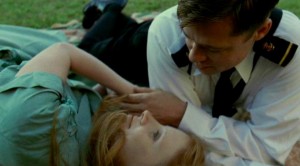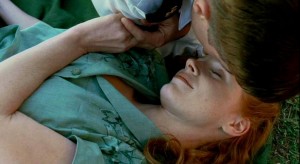
“A film is, or should be, more like music than like fiction. It should be a progression of moods and feelings. The theme, what’s behind the emotion, the meaning, all that comes later.” – Stanley Kubrick (1928-1999)
Brad Pitt is a man blessed with the gifts of family, able to provide his family a beautiful home on a serene 1950’s suburban street, has the respect of his wife and children. And although he has everything a man should need to live harmoniously, he loses his way. He misuses his authority to abuse his children, in the same way the big dinosaur bullied other smaller, vulnerable dinosaur in the “Big Bang” sequence. Pitt should be an esteemed father, but he has taken for granted the beauties and joys of the Earth. Just like so many of us do. It’s only at the end, when you confront death in the family, do you reconsider with awe how many blessings we have been bestowed in our time. You get to the end, and you want to take back all the bad behavior you exhibited, and rewind to the times when life was perfect, blissful, idyllic. We spend so much time reminiscing about the perfect times than living in the present times, and in human frailty, we allow ourselves to self-destruct in the present. This is best simple way to explain The Tree of Life (click for original review), a film that has elevated so many viewers’ lives and yet baffled so many others.
It has now been one year since Terrence Malick’s “The Tree of Life” hit theaters in the U.S. In that time, I’ve observed time and time again the immaculate performances. Jessica Chastain, as Pitt’s wife is perfect. Hunter McCracken, as Pitt’s unruly son, is as precocious a child actor that a director could hope for. But I’m past doing conventional praising of an extraordinary film that transcends ordinary description.
This past year I have been tirelessly thinking, pondering over and over again, how to explain this film to the unconverted, to the bewildered. The philosophical interpretations fill up more of my day-to-day than you could ever believe, I do not exaggerate.
 I’ve been told plenty of times how “boring” this film is. I assert with absolute honesty that I play “Tree of Life” at home, on my new Blu-Ray, more often than any other film in my library. I obviously am not one that finds it boring. After going through the film enough times, and raising my philosophical interpretations, I can’t think of a better film in my library where I can literally shut my brain off and watch. Yes, I’m aware that many viewers get headaches trying to figure out what “Tree of Life” is trying to say. I’ve finally come to the realization, don’t think at all.
I’ve been told plenty of times how “boring” this film is. I assert with absolute honesty that I play “Tree of Life” at home, on my new Blu-Ray, more often than any other film in my library. I obviously am not one that finds it boring. After going through the film enough times, and raising my philosophical interpretations, I can’t think of a better film in my library where I can literally shut my brain off and watch. Yes, I’m aware that many viewers get headaches trying to figure out what “Tree of Life” is trying to say. I’ve finally come to the realization, don’t think at all.
 Don’t Think. If you’re watching it for the first time, or for the second time trying to figure out what it means, Don’t Think. That’s the answer I’ve come up with. Turn off your brain and muse over it as an inquisitive 5-year old child would consider the Universe for the first time. A 5-year old mind isn’t trying to conquer “answers.” The 5-year old is in awe by the beauty and majesty of the images. You don’t find yourself dissecting the meaning of great music, do you? When you hear great music you let it surge through your body with a transcendent nature that isn’t left to raking for analysis. Like all great music, “Tree of Life” is too magnificent for that.
Don’t Think. If you’re watching it for the first time, or for the second time trying to figure out what it means, Don’t Think. That’s the answer I’ve come up with. Turn off your brain and muse over it as an inquisitive 5-year old child would consider the Universe for the first time. A 5-year old mind isn’t trying to conquer “answers.” The 5-year old is in awe by the beauty and majesty of the images. You don’t find yourself dissecting the meaning of great music, do you? When you hear great music you let it surge through your body with a transcendent nature that isn’t left to raking for analysis. Like all great music, “Tree of Life” is too magnificent for that.
Let me switch gears for a moment. If there’s anything in this world that I’m bewildered by, it’s when I go to art museums at the Metropolitan in New York, or the Getty in Los Angeles, and observe people “studying” at paintings for ten minutes at a time. I’m an impatient man, I admit that’s something I’m working on. But I often want to tell them, “Can you scoot over a foot so I can look at it head-on. I’m only going to take 30 seconds.” Yet I find them there, these art fawners, for maybe another ten minutes after that, “admiring” and “scrutinizing” a painting. A painting that doesn’t move. A painting has but one image. A painting doesn’t get any deeper if you spend one more minute reflecting over. I love paintings just like I love all art, but especially a second-rate painting (I don’t care if it’s 200-years old), can only muster so much deepness for me.
Yet I wonder how these art fawners at museums would respond to “The Tree of Life.” This is virtually the only film ever made with THOUSANDS of images worth hanging at a museum. And they are moving images. And each cut is to another image equally as breathtaking, or an expression taken to new revelatory heights. I respond deeply to every new image that unfolds. And I respond to it like great music, it surges through my body. It’s that transcendent. I DON’T THINK when I watch “The Tree of Life.”
So if you’re lost, all you need to do is return to my first paragraph of this article, and you got everything you need to know to set the ground work. The rest is left up to your interpretation, and whatever free-association thoughts that stream through your mind. Great cinema opens up the mind, remember that.
Yes, THOUSANDS of images. Any film that contains such a blessing should lend to an amended definition to the word masterpiece. “The Tree of Life” fits that definition ardently.
Previous posts on “The Tree of Life”:
- http://flickminute.com/tree-life/
- http://flickminute.com/tree-life-midnight-paris-unsettling-long-montages/
- http://flickminute.com/tree-life-second-time-around/
- http://flickminute.com/best-and-worst-films-2011/
139 Minutes. Rated PG-13.
Film Cousins: “2001: A Space Odyssey” (1968); “The Man Who Fell to Earth” (1976); “Days of Heaven” (1978); “Baraka” (1992).








